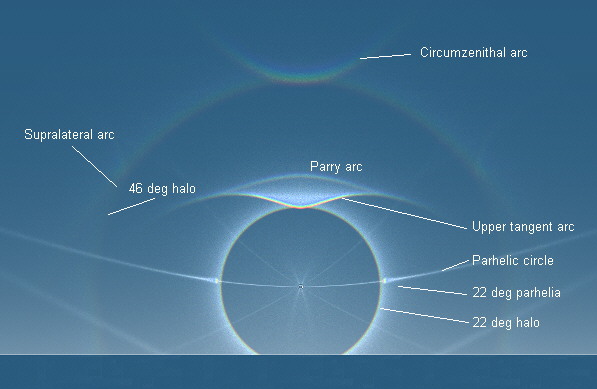
HALO3 simulation of
the rare UK display. The sun is below centre inside the bright
circular 22° halo.
30
million virtual light rays were traced through mathematical representations of
the cloud ice crystals to
make this view
as would be photographed by a wide angle camera.
Halos, produced by hexagonal shaped ice crystals in
clouds, are visible once or twice a week on
average.
These are usually sundogs and fragments of a
22° radius circular halo around the sun. In complex
displays
a whole variety of bright and colourful arcs
spread across the sky including ones rarely seen. In the
UK
these displays are few and far between but one was
visible over the Midlands and Northern England
on
Friday 9th February .
The sightings of common and rare
halo arcs were:
| |
|
Observer |
Location |
Time |
Arcs visible |
| |
|
Malcolm
Garland |
Sheffield |
12.40 -
13.10 |
1 2 4 5 6 7
8 |
| |
|
Malcolm
Goldsmith |
Prestwich, Manchester |
10.30 &13.30 |
2
10 |
| |
|
Gill
Smith |
Ashberry
near Rievaulx Abbey, Yorkshire |
13.30 -
14.00 |
1 2 3 4 5 7 9 |
| |
|
Ant Veal
et.al. |
Birmingham |
11.45 -
12.40 |
1 2 3 4 5
9
10 |
| |
|
Tony
Young |
Derby |
12.00 -
13.15 |
1 2 4 5 6 7 |
The halos:
| |
|
Key |
Name |
Cloud crystals |
|
|
| |
|
1 |
22° halo |
poorly oriented
crystals
|
Weak in display
|
|
| |
|
2 |
22° sundogs
(parhelia) |
hexagonal plates
|
|
|
| |
|
3 |
Circumzenithal arc |
plates
|
|
|
| |
|
4 |
Upper tangent arc |
horizontal
columns
|
Extremely bright and coloured |
|
| |
|
5 |
Parhelic circle |
plates
& columns
|
|
|
| |
|
6 |
Sun pillar |
plates
& columns |
Not often seen when the sun is so high.
Probably
made by the large numbers of column
crystals.
|
|
| |
|
7 |
46° halo |
poorly
oriented |
Rare and colourful halo - see supralateral
arc.
|
|
| |
|
8 |
120° parhelia |
plates |
Produced by multiple reflections inside plate
crystals.
|
|
| |
|
9 |
Parry arc |
Parry
columns |
Rare halo first seen by Parry in 1820 while
icebound
in the Arctic.
|
|
| |
|
10 |
Supralateral arc |
columns |
The sun was 18 to 22° high and these altitudes
it
can be difficult to distinguish between partial
supralateral
arcs and 46° halo fragments.
Crystals capable of
generating each were present but
the hexagonal columns
which generate supralateral arcs were most
abundant.
|
|

